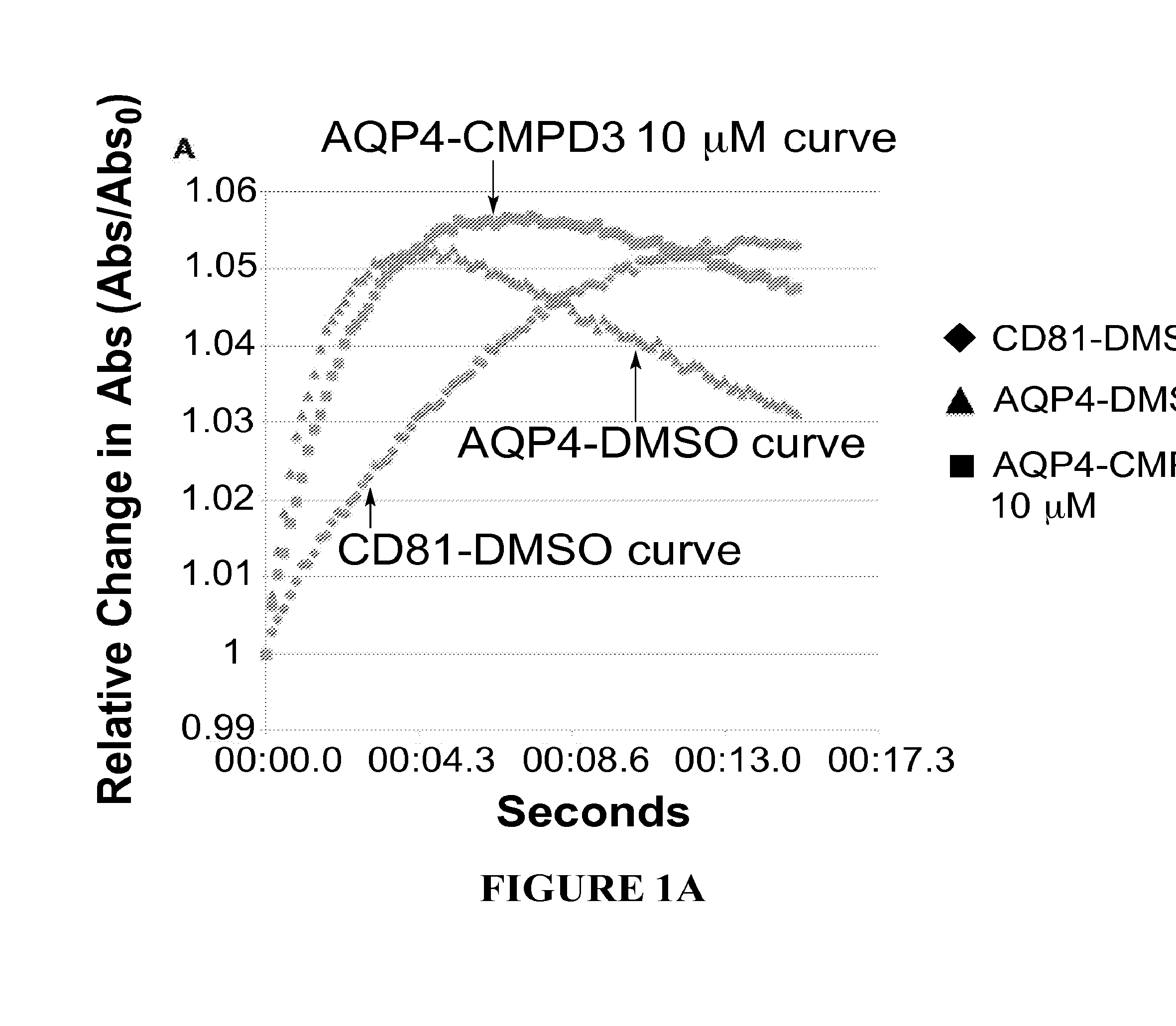Methods
a technology of selective aquaporin and inhibitor, applied in the field of selective aquaporin inhibitor, can solve the problems of increased intracerebral pressure, corresponding decrease in cerebral perfusion, and potential permanent or fatal brain damag
- Summary
- Abstract
- Description
- Claims
- Application Information
AI Technical Summary
Benefits of technology
Problems solved by technology
Method used
Image
Examples
example 1
Phenylbenzamide-AQP Structure-Activity Relationship
[0482]Structure activity relationships (SARs) are determined by assaying analogues of selected hits to guide chemistry for the preparation of new molecules to be tested for improved potency. For this iterative process we use a quantitative kinetic assay—the Aquaporin-Mediated Cell Volume Change Assa—in a 96-well multiplate reader. It detects changes in light scattering by a monolayer of CHO cells expressing the desired AQP as they shrink when exposed to hypertonic solution (300 mOsm→530 mOsm). FIG. 1 depicts the aquaporin-mediated cell volume change assay with AQP4 expressing cells (FIG. 1A) and AQP2 expressing cells (FIG. 1B). The cells expressing aquaporins shrink more rapidly than control cells, due to enhanced water flow, which shrinkage can be inhibited by a compound that inhibits the aquaporin.
[0483]In FIG. 1, aquaporin-expressing cells are shown in the presence of DMSO (triangles) or in the presence of the test compound (here...
example 2
Aquaporin Specificity of the Phenylbenzamide Compounds
[0486]The specificity of the compounds is tested against the most closely related of the 13 known aquaporins: AQP1, AQP2, AQP5 and both splice variants of AQP4 (A and B). A stable CHO cell line is created for each of the above aquaporins and the inhibition of water permeability using the Aquaporin-Mediated Cell Volume Change Assay with 10 μM Compound 3 is tested. Compound 3 inhibits AQP2 and 4, while it poorly inhibits AQP1and 5 (FIG. 2).
example 3
Direct Drug-Target Interactions Between Phenylbenzamides and AQP4
[0487]To support the mechanism of action by which phenylbenzamides directly block AQP4, we perform in vitro binding studies using purified AQP4b and Compound 4 radiolabeled with 3H. Using a Hummel-Dryer style assay, a gel filtration column is equilibratrated with buffer containing detergent, to maintain solubility of AQP4b, and 1 μM [3H]-Compound 4. AQP4b is diluted to 250 μM in this column buffer and incubated at RT for 30 min. The sample is then applied to the column, fractions collected and the presence of [3H]-Compound 4 detected by liquid scintillation counting. FIG. 3 shows the elution profile of [3H]-Compound 4 from the gel filtration column with the elution positions of tetrameric and monomeric AQP4b indicated. The rise in [3H]-Compound 4 from a baseline value of 1 μM represents binding to each of these proteins. Although no monomeric AQP4b can be readily detected in our highly purified AQP4b by conventional me...
PUM
| Property | Measurement | Unit |
|---|---|---|
| Microgravity | aaaaa | aaaaa |
Abstract
Description
Claims
Application Information
 Login to View More
Login to View More - R&D
- Intellectual Property
- Life Sciences
- Materials
- Tech Scout
- Unparalleled Data Quality
- Higher Quality Content
- 60% Fewer Hallucinations
Browse by: Latest US Patents, China's latest patents, Technical Efficacy Thesaurus, Application Domain, Technology Topic, Popular Technical Reports.
© 2025 PatSnap. All rights reserved.Legal|Privacy policy|Modern Slavery Act Transparency Statement|Sitemap|About US| Contact US: help@patsnap.com



